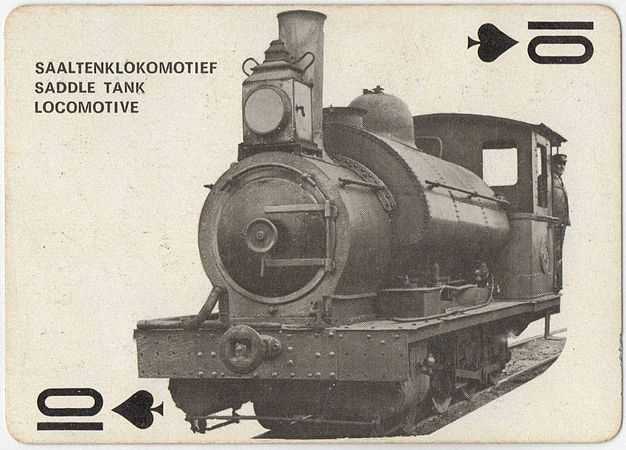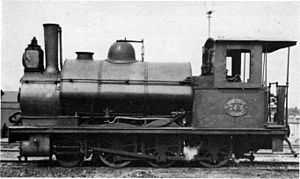CGR 1st Class 2-6-0ST 1876
| CGR 1st Class 2-6-0ST 1876 to South African Class 01 2-6-0ST | |
|---|---|
|
CGR 1st Class 2-6-0ST no. M16 SAR Class 01 2-6-0 ST no. 0416 | |
| Type and origin | |
| Power type | Steam |
| Designer | Kitson and Company |
| Builder | Kitson and Company |
| Serial number | 2046-2047 |
| Model | 2-6-0T "Mogul" Back-to-Back |
| Build date | 1876 |
| Total produced | 1 pair |
| Rebuilder | Cape Government Railways |
| Rebuild date | c. 1881 |
| Number rebuilt | 2 |
| Specifications | |
| Configuration | Rebuilt to 2-6-0ST "Mogul" |
| Gauge | 3 ft 6 in (1,067 mm) Cape gauge |
| Leading wheel diameter | 24 in (610 mm) |
| Driver diameter | 39 in (991 mm) |
| Wheelbase |
7 ft 9 in (2.362 m) coupled 11 ft 4 in (3.454 m) engine [1] |
| Length | 22 ft 9 1⁄2 in (6.947 m) over couplers |
| Height | 11 ft 4 1⁄2 in (3.467 m) |
| Axle load | 7 8⁄20 long tons (7.5 t) on middle driver |
| Weight on drivers | 20 7⁄20 long tons (20.7 t) |
| Locomotive weight | 25 13⁄20 long tons (26.1 t) w/o |
| Fuel type | Coal |
| Fuel capacity | 1⁄2 long ton (0.5 t) |
| Water capacity | 520 imp gal (2,400 l; 620 US gal) |
| Boiler | 5 ft 3 in (1.600 m) pitch [1] |
| Boiler pressure | 140 psi (970 kPa) |
| Firegrate area | 10 sq ft (0.929 m2) |
| Heating surface: – Tubes | 483 sq ft (44.872 m2) |
| – Firebox | 49 sq ft (4.6 m2) |
| – Total | 532 sq ft (49.4 m2) |
| Cylinders | Two |
| Cylinder size |
12 in (305 mm) bore 20 in (508 mm) stroke |
| Valve gear | Stephenson |
| Performance figures | |
| Tractive effort | 7,754 lbf (34 kN) at 75% pressure |
| Career | |
| Operator(s) |
Cape Government Railways South African Railways |
| Class | CGR 1st Class, SAR Class 01 |
| Number in class | 2 |
| Number(s) | M15-M16 |
| Delivered | 1876 |
| First run | 1876 [2][3][4] |
The CGR 1st Class 2-6-0ST of 1876 is a South African steam locomotive from the pre-Union era in the Cape Colony.
In 1876 the Cape Government Railways placed a pair of back-to-back 2-6-0 Mogul type side-tank locomotives in service on the Cape Midland system, built by Kitson. They were later separated and rebuilt to saddle-tank locomotives for use as shunting engines. When a classification system was introduced, they were designated 1st Class.[2][4]
Manufacturer
A pair of Mogul type 2-6-0 side-tank locomotives were delivered to the Cape Government Railways (CGR) from Kitson and Company in 1876, arriving in Port Elizabeth on the ship Queen of the West on 21 February and numbered M15 and M16 for the Midland System.[2][4][5]
Chacteristics
The locomotives were built as Stephenson’s Patent permanently coupled back-to-back tank locomotives, a configuration that allowed the two locomotives to be operated by a single crew. A similar pair of 0-6-0T back-to-back locomotives was delivered to the Eastern System in East London in that same year, built by Robert Stephenson and Company.[1][5]
Service
Cape Government Railways
It is not known whether this back-to-back pair displayed the same instability in operation as the 0-6-0T back-to-back locomotive pair on the Eastern System, but by 1881 they had also been separated. In the process they were rebuilt to saddle-tank engines for use in shunting service in Port Elizabeth, where they spent the rest of their service lives. When a classification system was introduced on the CGR, they were designated 1st Class.[2][3][4][5][6]
Both locomotives were renumbered more than once during the CGR era. By 1886 the system prefix M was replaced by the numeral 1 and they were renumbered at least twice more, to 215 and 216 by 1890 and to 415 and 416 by 1896.[2][4][6]
South African Railways
The Union of South Africa was established on 31 May 1910, in terms of the South Africa Act. One of the clauses in the Act required that the three Colonial Government railways, the CGR, the Natal Government Railways and the Central South African Railways (CSAR), also be united under one single administration to control and administer the railways, ports and harbours of the Union. While the South African Railways (SAR) came into existence in 1910, the actual classification and renumbering of all the rolling stock of the three constituent railways required careful planning and was only implemented with effect from 1 January 1912.[6][7]
By 1912 both locomotives still survived to be taken onto the SAR roster. Since they were considered obsolete by the SAR, the locomotives were designated Class 01 and renumbered by having the numeral 0 prefixed to their existing numbers. Even though they were considered obsolete and no. 0415 was scrapped in 1916, no. 0416 was only scrapped in 1946 after seventy years in service.[3][4][6][8]
Sides illustrated
A front view of the rebuilt saddle-tank version is illustrated below, showing no. 0416 that started its career as half of the Stephenson's Patent permanently coupled back-to-back pair in 1876.
-

SAR Class 01 2-6-0 ST no. 0416, front view
See also
- CGR 0-6-0T 1876 Back-to-Back
- CGR 1st Class 2-6-0 1876 BP
- CGR 1st Class 2-6-0 1876 Kitson
- CGR 1st Class 2-6-0 1879
- CGR 1st Class 2-6-0 1891
- The 2-6-0 "Mogul"
- South African locomotive history
- List of South African locomotive classes
References
|
- ↑ 1.0 1.1 1.2 Wiener, Lionel. Articulated Locomotives. pp. 508-509, 511.
- ↑ 2.0 2.1 2.2 2.3 2.4 Holland, D.F. (1971). Steam Locomotives of the South African Railways, Volume 1: 1859-1910 (1st ed.). Newton Abbott, Devon: David & Charles. pp. 28, 106. ISBN 978-0-7153-5382-0.
- ↑ 3.0 3.1 3.2 Holland, D.F. (1972). Steam Locomotives of the South African Railways, Volume 2: 1910-1955 (1st ed.). Newton Abbott, Devon: David & Charles. pp. 118–121. ISBN 978-0-7153-5427-8.
- ↑ 4.0 4.1 4.2 4.3 4.4 4.5 C.G.R. Numbering Revised, Article by Dave Littley, SA Rail May–June 1993, pp. 94-95.
- ↑ 5.0 5.1 5.2 Back-to-back - The known facts
- ↑ 6.0 6.1 6.2 6.3 Classification of S.A.R. Engines with Renumbering Lists, issued by the Chief Mechanical Engineer’s Office, Pretoria, January 1912. (Reprinted in April 1987 by SATS Museum, R.3125-6/9/11-1000)
- ↑ The South African Railways - Historical Survey. Editor George Hart, Publisher Bill Hart, Sponsored by Dorbyl Ltd., Published c. 1978, p. 25.
- ↑ Paxton, Leith; Bourne, David (1985). Locomotives of the South African Railways (1st ed.). Cape Town: Struik. p. 16. ISBN 0869772112.
